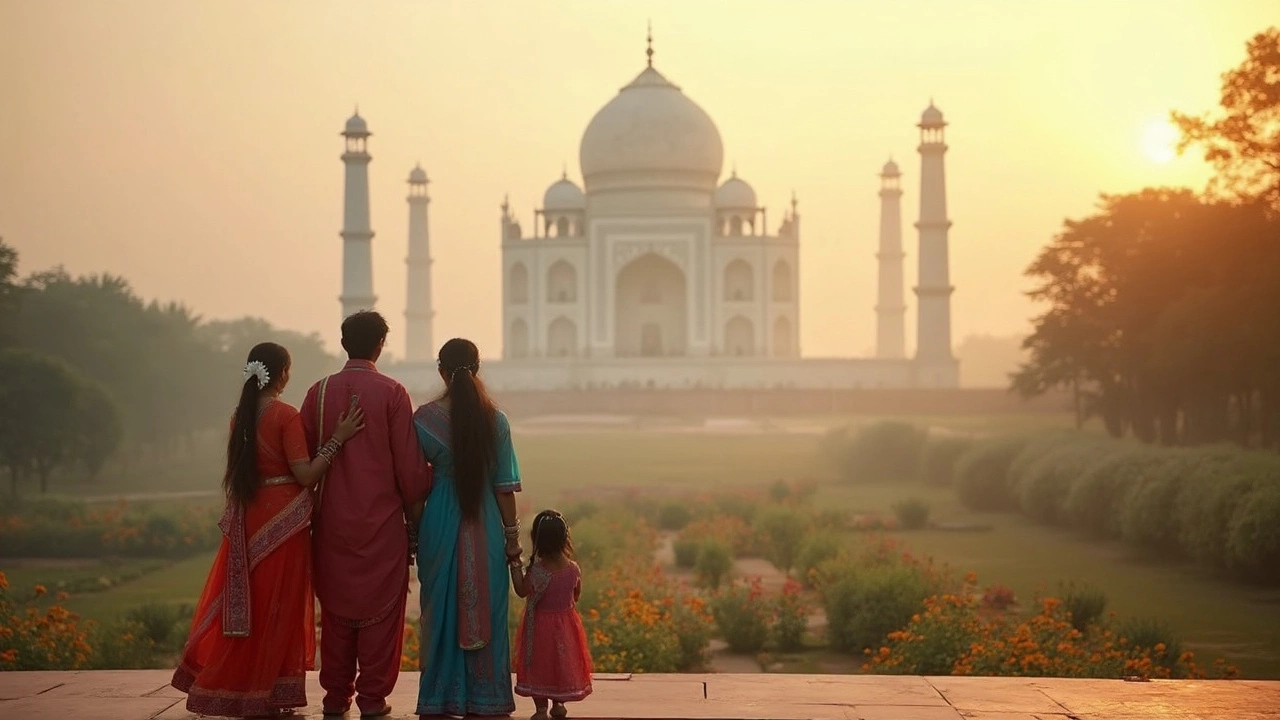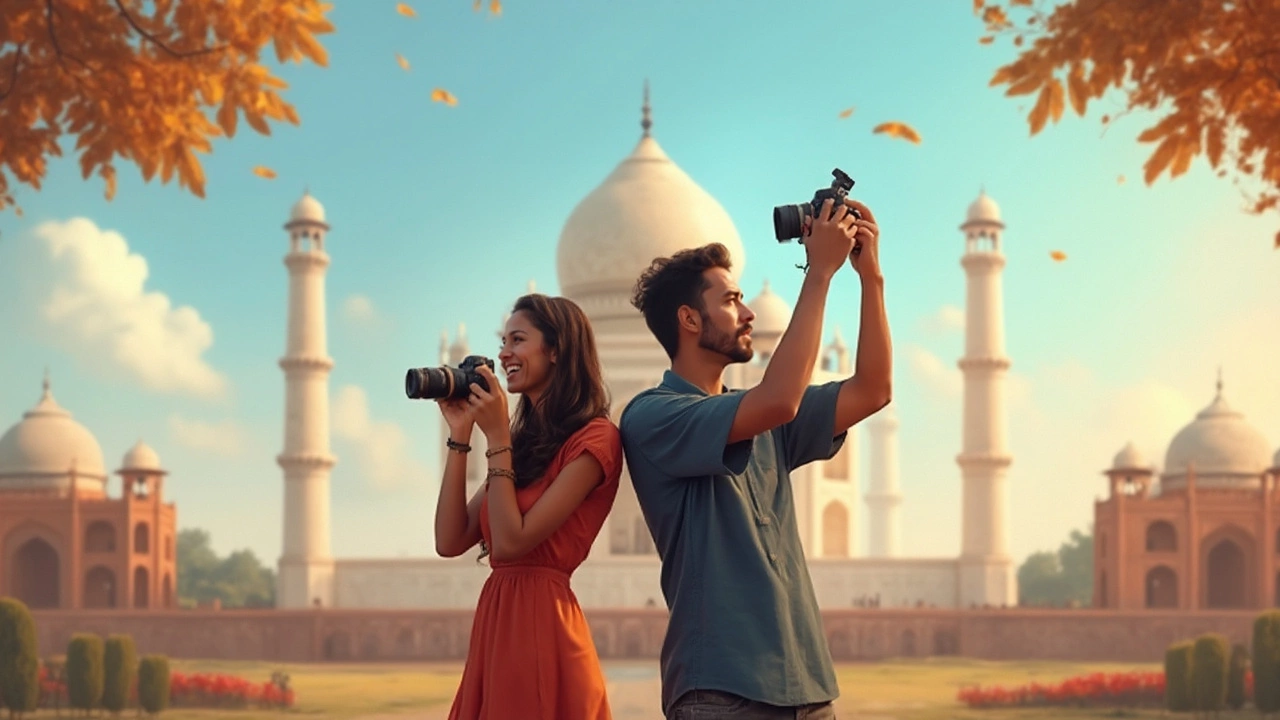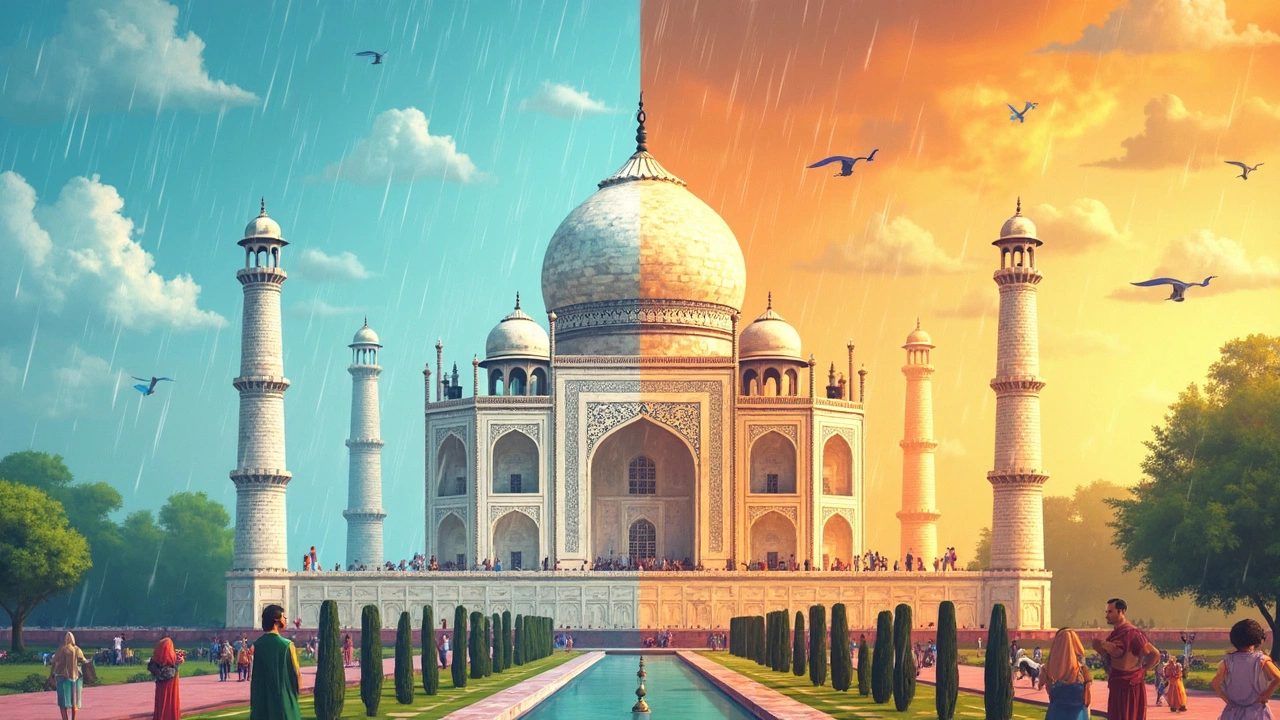Best Month to Visit the Taj Mahal: Timing Your Trip for an Epic Experience
 Jun, 2 2025
Jun, 2 2025
Most people don't realize the month you visit the Taj Mahal can make or break your whole trip. Go at the wrong time, and you could end up wiping sweat off your forehead, waiting in endless lines, or squinting at a hazy view. The right month means better photos, cooler weather, and a chance to really enjoy one of the world’s biggest bucket-list sights.
The Taj Mahal stands in Agra, smack in the middle of North India’s wild weather swings—a scorching summer, heavy monsoon rains, and a winter that actually feels comfortable. Picking the best time isn’t just about keeping cool. It’s about beating the crowds, catching the perfect sunrise shot, and not letting pollution ruin your view. There’s a sweet spot to hit, and I’ll break it all down so you don’t have to guess.
- Why Timing Matters
- Breaking Down Taj Mahal Seasons
- Avoiding Crowds and Scorching Sun
- Scoring the Best Photos
- Pro Tips for a Smooth Visit
Why Timing Matters
Ask anyone who’s traveled to Agra during the wrong month, and you’ll get the same story: the heat can feel brutal, monsoon showers soak your plans, or fog hides the Taj Mahal when you’re dying for a selfie. This iconic spot sees over seven million visitors a year, so timing isn’t just about comfort—it can seriously affect what you see and how much you enjoy it.
Summer temperatures in Agra between April and June can crank up beyond 40°C (104°F). It's not just about sweat; dehydration, sunburn, and endless waiting in the sun are real problems. Winters (November to February) are way more comfortable, but early mornings sometimes bring thick fog that covers the Taj Mahal’s famous white marble.
If you plan your visit in sync with local weather patterns and tourist season, you score better views, thinner crowds, and more energy to actually enjoy walking around this massive place. Here’s a quick breakdown so you know what to expect each season:
| Season | Months | What to Expect |
|---|---|---|
| Winter | Nov – Feb | Cool and pleasant, but possible morning fog |
| Spring | Mar – early Apr | Warm but not boiling, less fog |
| Summer | Apr – June | Very hot, fewer visitors, harsh sun |
| Monsoon | July – Sept | Heavy rain, muddy grounds, unpredictable |
| Post-monsoon/Autumn | Oct | Fresh air, pleasant temps, clear views |
Plus, the Taj Mahal is closed every Friday for prayers and can get extra busy on weekends, school holidays, and during India’s major festivals. The best timing dodges both nature’s curveballs and people-packed days.
Breaking Down Taj Mahal Seasons
The weather in Agra isn’t just one thing all year—it flips from blazing hot to cool and foggy, then to sticky and wet depending on the month. If you show up without checking this, you might get more than you bargained for. Here’s how each season changes the vibe at the Taj Mahal and what it means for your trip.
- Winter (November to February): This is the time most travelers swear by. Days are mild—think 8°C to 22°C (46°F to 72°F)—and the sky usually stays clear. You’ll still get crowds, especially at sunrise, but standing in line sure beats sweating it out. Just watch out for fog in December and January, it can blur your sunrise view and hide the Taj for an hour or two in the mornings.
- Spring (March): March sits in that sweet spot before summer. Temperatures go from cool to warm, ranging from 15°C to 30°C (59°F to 86°F). Colorful flowers bloom in the gardens, which makes photos pop. Crowds are still big, but weather-wise, it’s a solid time to go.
- Summer (April to June): Agra goes full blast with heat—temps often soar past 40°C (104°F). Tour groups thin out ’cause afternoons are brutal. If you go now, try an early visit, but honestly, sightseeing in this heat is not much fun. Locals leave town if they can.
- Monsoon (July to September): Rainstorms roll through, and humidity jumps through the roof. Temps cool down a bit to around 25°C to 35°C (77°F to 95°F), but the air’s thick and sticky. On the plus side, gardens go super green and striking for photos. You still get fewer crowds, but you could get rained out some days. Pack a raincoat and instant coffee for those surprise delays.
- Autumn (October): The city dries out, air clears up, and the festival season kicks in. Weather is pleasant—usually 18°C to 32°C (64°F to 89°F). It’s a top pick since there’s less fog than winter and no rain to dodge. Diwali sometimes falls in October, which adds colorful lights all over Agra.
Here’s a quick cheat sheet:
| Season | Months | Avg Temp (°C) | Main Pros | Main Cons |
|---|---|---|---|---|
| Winter | Nov-Feb | 8–22 | Cool weather, clear skies | Occasional morning fog |
| Spring | March | 15–30 | Flowers blooming | Growing crowds |
| Summer | Apr-Jun | 28–45 | Few crowds | Extreme heat |
| Monsoon | Jul-Sep | 25–35 | Green gardens, less busy | Heavy rains, humidity |
| Autumn | Oct | 18–32 | Pleasant, festival vibes | Some post-monsoon dampness |
This breakdown should help you pick a window that matches your comfort and style—whether you’re chasing crisp winter mornings, dodging crowds, or hoping for postcard-perfect gardens.

Avoiding Crowds and Scorching Sun
If you’re all about seeing the Taj Mahal without elbow-to-elbow crowds or melting in the heat, timing matters—a lot. Agra’s summer hits hard from April through June, with temperatures shooting up to 45°C (113°F). Stand outside for more than 10 minutes in that, and you’ll be looking for shade faster than you can say “marble.” The heat isn’t just uncomfortable; it can zap your energy and mess up your experience.
Winter, from November to February, feels way better, with daytime highs hanging around 20-25°C (68-77°F). That’s perfect for wandering the gardens, snapping photos, and not worrying about sunstroke. Locals and regulars swear by these months, but here’s the thing: everyone else thinks so too. Expect higher crowds, especially around major holidays like Christmas, New Year’s, and India’s Republic Day on January 26th.
If you want a sweet spot, aim for early March or late October—just outside the busiest winter months. The weather’s still pleasant, but tour bus numbers drop and queues are shorter. Strictly avoid Indian school holidays (May-June) and weekends if you want breathing room on the grounds. For the fewest people, go on a weekday right when the gates open at sunrise.
- Skip midday (10am-3pm): Sun’s at its harshest, and lines are longest.
- Arrive before 7am: You’ll get softer light and fewer tour groups.
- Weekdays are quieter: Fridays are out, since the Taj Mahal’s closed to the public.
Another thing you might not expect: Agra’s air pollution. By late winter and into spring, haze can make photos look washed-out. That’s another reason why those early morning visits are golden—the air’s cleaner and you’ll get a clearer view of this Taj Mahal icon before the city really wakes up.
Scoring the Best Photos
If snapping epic shots is on your mind, then timing your Taj Mahal visit right can seriously upgrade your camera roll. The number one thing you should know is that winter months—especially November to February—offer the clearest and brightest skies. There’s less haze and the sunlight is soft, especially around sunrise and sunset. These months make colors pop and those iconic marble domes look even more unreal.
Mornings are key. The gates open at sunrise and that’s when the crowds are thinnest. You can get those classic wide shots without someone’s selfie stick in the frame. Plus, the early light casts this gentle glow on the marble, giving it a golden or pink touch (depends on the day!). By midday, overhead sun can wash out your photos and bring out long shadows, and honestly, it gets really sweaty out there.
Want the classic reflection shot across the pool? Aim to get there as soon as it opens. A still, windless morning will deliver a perfect mirror image. For cool crowd-free angles, explore the area around the mosque and the guest house on the west and east of the main tomb—these spots often get overlooked but give killer side views and unique backgrounds.
- Try arriving about 15 minutes before opening. Weekdays, especially Tuesdays to Thursdays, are way less crowded than weekends.
- Bring a wide-angle lens if you have one—getting the whole monument in frame is tougher up close than you’d think.
- The main gate (Darwaza-i rauza) is famous for its framed arch shot. Snap your photo before everyone pours in.
- Don’t bother with tripods—security usually bans them, so go handheld.
One thing to keep in mind: avoid visiting for photos during June to September. That's when the monsoon is out in full force, and the sky can look dull or flat out gray, while humidity can fog your camera lens. In the best months, Agra’s air is clearer, and you’ll get those postcard-worthy shots. That's what makes the Taj Mahal the place for legendary travel photos—if you get the timing right.

Pro Tips for a Smooth Visit
You’ve picked the perfect month. So how do you make the most of your day at the Taj? A little planning seriously pays off—especially with this much history and popularity packed into one spot.
- Book your ticket online. Skipping the ticket line saves at least 30 minutes, sometimes way more on weekends. The official Archaeological Survey of India website is the legit spot—don’t fall for third-party overcharges.
- Show up early. Gates open at sunrise, and the crowd is thinnest then. Early light on the marble is unreal, and it’s cooler, too.
- Bring a valid ID (passport for foreigners, Aadhaar for Indians). You’ll need this at security, and they do check.
- Only small bags are allowed. Security is strict—no snacks, lighters, tripods, or drones. Water bottles and your phone or camera are fine.
- If you want the classic photo, head straight to the Diana Bench before tour groups swarm it. No joke—lines form fast.
- Wear comfy shoes. You’ll walk a lot, and stone gets roasting hot by noon. There are shoe covers or you can walk barefoot on the main platform, but those covers run out on busy days.
- Hire a licensed guide inside, not outside the gates. Official guides wear badges and know their stuff. Scammy offers out front are common.
If you care about numbers, check out this table showing the average daily visitor count. Weekends and holidays swell fast—it’s not unusual for Taj Mahal entrances to top 30,000 in December and January peak.
| Month | Average Daily Visitors | Notes |
|---|---|---|
| November-February | 20,000 - 30,000 | Peak season, cooler weather, bigger crowds |
| March | 15,000 - 22,000 | Pleasant, less crowded after Holi |
| April-June | 12,000 - 18,000 | Hotter, but easier entry |
| July-September | 8,000 - 14,000 | Monsoon, fewer tourists |
| October | 15,000 - 23,000 | Weather improves, crowds pick up |
Lastly, try to catch Mehtab Bagh across the river for sunset—best way to see the whole monument without the crowds, and you can chill after the morning rush. Agra is chaotic at times, but with these steps, your visit won’t be.